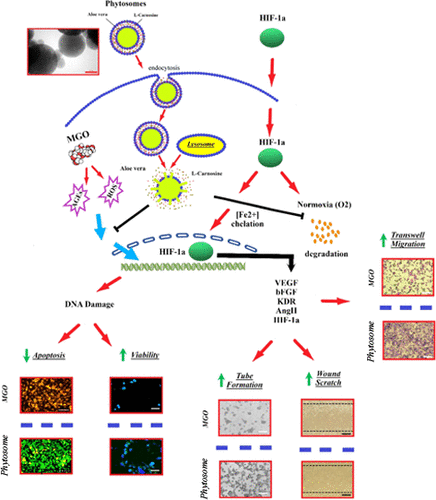当前位置:
X-MOL 学术
›
Mol. Pharmaceutics
›
论文详情
Our official English website, www.x-mol.net, welcomes your
feedback! (Note: you will need to create a separate account there.)
Dual l-Carnosine/Aloe vera Nanophytosomes with Synergistically Enhanced Protective Effects against Methylglyoxal-Induced Angiogenesis Impairment
Molecular Pharmaceutics ( IF 4.5 ) Pub Date : 2021-07-23 , DOI: 10.1021/acs.molpharmaceut.1c00248 Behrad Darvishi 1, 2 , Rassoul Dinarvand 3, 4 , Hadiseh Mohammadpour 5 , Tunku Kamarul 6 , Ali Mohammad Sharifi 1, 2, 6, 7
Molecular Pharmaceutics ( IF 4.5 ) Pub Date : 2021-07-23 , DOI: 10.1021/acs.molpharmaceut.1c00248 Behrad Darvishi 1, 2 , Rassoul Dinarvand 3, 4 , Hadiseh Mohammadpour 5 , Tunku Kamarul 6 , Ali Mohammad Sharifi 1, 2, 6, 7
Affiliation

|
Microvascular complications are among the major outcomes of patients with type II diabetes mellitus, which are the consequences of impaired physiological functioning of small blood vessels and angiogenic responses in these patients. Overproduction and accumulation of methylglyoxal (MGO), a highly reactive dicarbonyl byproduct of glycolysis pathway, has been acclaimed as the main inducer of impaired angiogenic responses and microvascular dysfunction in diabetic patients with uncontrolled hyperglycemia. Hence, an effective approach to overcome diabetes-associated microvascular complications is to neutralize the deleterious activity of enhanced the concentration of MGO in the body. Owing to the glycation inhibitory activity of Aloe vera whole extract, and capability of l-carnosine, an endogenous dipeptide, in attenuating MGO’s destructive activity, we examined whether application of a combination of l-carnosine and A. vera could be an effective way of synergistically weakening this reactive dicarbonyl’s impaired angiogenic effects. Additionally, overcoming the poor cellular uptake and internalization of l-carnosine and A. vera, a nanophytosomal formulation of the physical mixture of two compounds was also established. Although l-carnosine and A. vera at whole studied combination ratios could synergistically enhance viability of human umbilical vein endothelial cells (HUVECs) treated with MGO, the 25:1 w/w ratio was the most effective one among the others (27 ± 0.5% compared to 12 ± 0.3 to 18 ± 0.4%; F (4, 15) = 183.9, P < 0.0001). Developing dual nanophytosomes of l-carnosine/A. vera (25:1) combination ratio, we demonstrated superiority of the nanophytosomal formulation in protecting HUVECs against MGO-induced toxicity following a 24–72 h incubation period (17.3, 15.8, and 12.4% respectively). Moreover, 500 μg/mL concentration of dual l-carnosine/A. vera nanophytosomes exhibited a superior free radical scavenging potency (63 ± 4 RFU vs 83 ± 5 RFU; F (5, 12) = 54.81, P < 0.0001) and nitric oxide synthesizing capacity (26.11 ± 0.19 vs 5.1 ± 0.33; F (5, 12) = 2537, P < 0.0001) compared to their physical combination counterpart. Similarly, 500 μg/mL dual l-carnosine/A. vera nanophytosome-treated HUVECs demonstrated a superior tube formation capacity (15 ± 3 vs 2 ± 0.3; F (5, 12) = 30.87, P < 0.001), wound scratch healing capability (4.92 ± 0.3 vs 3.07 ± 0.3 mm/h; F (5, 12) = 39.21, P < 0.0001), and transwell migration (586 ± 32 vs 394 ± 18; F (5, 12) = 231.8, P < 0.001) and invasion (172 ± 9 vs 115 ± 5; F (5, 12) = 581.1, P < 0.0001) activities compared to the physical combination treated ones. Further confirming the proangiogenic activity of the dual l-carnosine/A. vera nanophytosomes, a significant shift toward expression of proangiogenic genes including HIF-1α, VEGFA, bFGF, KDR, and Ang II was reported in treated HUVECs. Overall, dual l-carnosine/A. vera nanophytosomes could be a potential candidate for attenuating type II DM-associated microvascular complications with an impaired angiogenesis background.
中文翻译:

双 l-肌肽/芦荟纳米植物体对甲基乙二醛诱导的血管生成损伤具有协同增强的保护作用
微血管并发症是 II 型糖尿病患者的主要结局之一,这是这些患者的小血管生理功能受损和血管生成反应受损的结果。甲基乙二醛 (MGO) 是糖酵解途径的高反应性二羰基副产物,其过量产生和积累被认为是高血糖不受控制的糖尿病患者血管生成反应受损和微血管功能障碍的主要诱因。因此,克服糖尿病相关微血管并发症的有效方法是中和提高体内 MGO 浓度的有害活性。由于芦荟全提取物的糖基化抑制活性,以及l-肌肽,一种内源性二肽,在减弱 MGO 的破坏性活性方面,我们检查了L-肌肽和A. vera的组合应用是否可以成为协同减弱这种反应性二羰基受损血管生成作用的有效方法。此外,克服了l-肌肽和A. vera细胞吸收和内化不良的问题,还建立了两种化合物物理混合物的纳米植物体制剂。虽然l-肌肽和A. vera在整个研究的组合比率可以协同增强用 MGO 处理的人脐静脉内皮细胞 (HUVEC) 的活力,25:1 w/w 比率是最有效的一种(27 ± 0.5% 与 12 ± 0.3 至 18 ± 0.4%;F (4, 15) = 183.9, P < 0.0001)。我们开发了l-肌肽/ A. vera (25:1) 组合比例的双纳米植物体,我们证明了纳米植物体制剂在 24-72 小时的潜伏期(17.3、15.8 和 12.4%)后在保护 HUVEC 免受 MGO 诱导的毒性方面的优越性分别)。此外,500 μg/mL 浓度的双l-肌肽/ A. vera纳米植物体表现出优异的自由基清除能力(63 ± 4 RFU vs 83 ± 5 RFU;F (5, 12) = 54.81, P < 0.0001)和一氧化氮合成能力(26.11 ± 0.19 vs 5.1 ± 0.33;F (5, 12) = 2537, P < 0.0001) 与其物理组合对应物相比。同样,500 μg/mL 双l-肌肽/ A. vera纳米植物体处理的 HUVEC 表现出优异的管形成能力(15 ± 3 vs 2 ± 0.3;F (5, 12) = 30.87, P < 0.001),伤口划痕愈合能力(4.92 ± 0.3 vs 3.07 ± 0.3 mm/h;F (5, 12) = 39.21, P < 0.0001)和跨井迁移(586 ± 32 vs 394 ± 18;F (5, 12) = 231.8, P< 0.001) 和入侵 (172 ± 9 vs 115 ± 5; F (5, 12) = 581.1, P < 0.0001) 活动与物理组合处理的活动相比。进一步证实了双l-肌肽/ A. vera纳米植物体的促血管生成活性,在处理的 HUVEC 中报道了包括 HIF-1α、VEGFA、bFGF、KDR 和 Ang II 在内的促血管生成基因表达的显着转变。总体而言,双l-肌肽/ A. vera纳米植物体可能是减轻具有受损血管生成背景的 II 型 DM 相关微血管并发症的潜在候选者。
更新日期:2021-09-06
中文翻译:

双 l-肌肽/芦荟纳米植物体对甲基乙二醛诱导的血管生成损伤具有协同增强的保护作用
微血管并发症是 II 型糖尿病患者的主要结局之一,这是这些患者的小血管生理功能受损和血管生成反应受损的结果。甲基乙二醛 (MGO) 是糖酵解途径的高反应性二羰基副产物,其过量产生和积累被认为是高血糖不受控制的糖尿病患者血管生成反应受损和微血管功能障碍的主要诱因。因此,克服糖尿病相关微血管并发症的有效方法是中和提高体内 MGO 浓度的有害活性。由于芦荟全提取物的糖基化抑制活性,以及l-肌肽,一种内源性二肽,在减弱 MGO 的破坏性活性方面,我们检查了L-肌肽和A. vera的组合应用是否可以成为协同减弱这种反应性二羰基受损血管生成作用的有效方法。此外,克服了l-肌肽和A. vera细胞吸收和内化不良的问题,还建立了两种化合物物理混合物的纳米植物体制剂。虽然l-肌肽和A. vera在整个研究的组合比率可以协同增强用 MGO 处理的人脐静脉内皮细胞 (HUVEC) 的活力,25:1 w/w 比率是最有效的一种(27 ± 0.5% 与 12 ± 0.3 至 18 ± 0.4%;F (4, 15) = 183.9, P < 0.0001)。我们开发了l-肌肽/ A. vera (25:1) 组合比例的双纳米植物体,我们证明了纳米植物体制剂在 24-72 小时的潜伏期(17.3、15.8 和 12.4%)后在保护 HUVEC 免受 MGO 诱导的毒性方面的优越性分别)。此外,500 μg/mL 浓度的双l-肌肽/ A. vera纳米植物体表现出优异的自由基清除能力(63 ± 4 RFU vs 83 ± 5 RFU;F (5, 12) = 54.81, P < 0.0001)和一氧化氮合成能力(26.11 ± 0.19 vs 5.1 ± 0.33;F (5, 12) = 2537, P < 0.0001) 与其物理组合对应物相比。同样,500 μg/mL 双l-肌肽/ A. vera纳米植物体处理的 HUVEC 表现出优异的管形成能力(15 ± 3 vs 2 ± 0.3;F (5, 12) = 30.87, P < 0.001),伤口划痕愈合能力(4.92 ± 0.3 vs 3.07 ± 0.3 mm/h;F (5, 12) = 39.21, P < 0.0001)和跨井迁移(586 ± 32 vs 394 ± 18;F (5, 12) = 231.8, P< 0.001) 和入侵 (172 ± 9 vs 115 ± 5; F (5, 12) = 581.1, P < 0.0001) 活动与物理组合处理的活动相比。进一步证实了双l-肌肽/ A. vera纳米植物体的促血管生成活性,在处理的 HUVEC 中报道了包括 HIF-1α、VEGFA、bFGF、KDR 和 Ang II 在内的促血管生成基因表达的显着转变。总体而言,双l-肌肽/ A. vera纳米植物体可能是减轻具有受损血管生成背景的 II 型 DM 相关微血管并发症的潜在候选者。











































 京公网安备 11010802027423号
京公网安备 11010802027423号